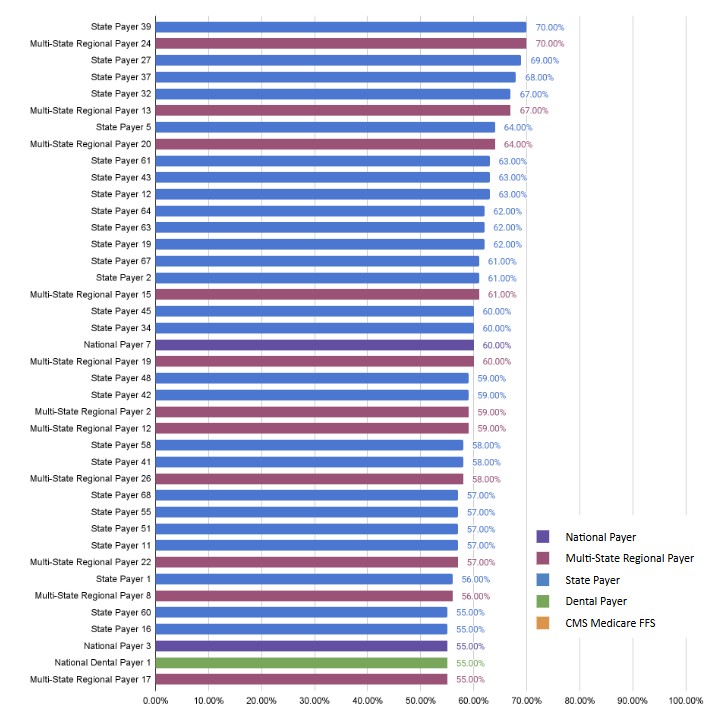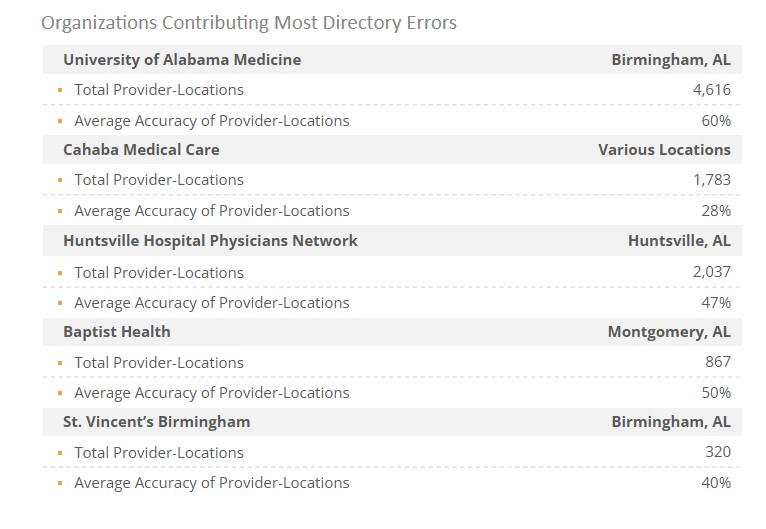Despite investing millions in master data management, data cleanup, and syndicating data through APIs and online directories, payers often lack an understanding of how accurate their provider directories are and how that stacks up with their industry peers. It has been 7 years since the last Medicare Advantage ‘Online Provider Directory Review Report’ that demonstrated a 45% accuracy deficiency rate across sampled Medicare Advantage directories. What, if anything, has changed since 2018, and what does that mean for payers’ provider data strategy?
Purpose of the National Provider Directory Accuracy Report
Defacto Health produced this report to illustrate the national and state-level range of accuracy results, highlight the highest levels of accuracy achieved, and identify the provider organizations associated with the most errors in payer directories. Our goal is to create a feedback loop for both payers and providers, helping them understand their performance and encouraging healthcare leaders to raise the bar for directory accuracy.
Methodology and approach
We used a hybrid approach, combining consensus algorithms with targeted phone audits, to assess the accuracy of 124 payer provider directories. Data was extracted from provider directory APIs and machine-readable files, standardized into a unified dataset, and analyzed to evaluate how consistently providers were listed across payers. The algorithm was calibrated using CMS-style ‘secret shopper’ phone audits to align with traditional audit methods, and phone validation showed this method reliably assesses relative directory accuracy. Scores were calculated at the network, geographic, and provider organization levels, and payers were categorized as National or State/Regional for consistent comparisons. State-level reports included payers with over 5% market share, with placeholders where data was missing to maintain transparency. We also identified provider organizations most frequently associated with directory errors to help payers target upstream improvements. The goal of the report is not to single out payers but to provide a clear industry benchmark and show what levels of accuracy are achievable.

Figure 1 – Payers with provider directories above 55% accurate nationally

Figure 2 – State level example: top payers in Alabama by covered lives, and their accuracy

Figure 3 – State level example: provider organizations associated with the most errors in directories
Key findings
Defacto found that only two payers reached 70% directory accuracy. State and regional payers, often Blues plans, consistently outperformed national payers, whose accuracy performance varied by market. This points to the potential importance of local strategies, provider education, and securing accurate data feeds from providers. We reached out to top performing payers to see what strategies they employed to achieve their relatively accurate directories, but we did not receive a response. Meanwhile, 35% of payers remain stuck between 45% and 55% accuracy, showing little improvement since CMS’s 2018 audits. Dental payers, likely facing less oversight, failed to exceed 56% accuracy. Low performers face the greatest regulatory risk, and could reach average levels through basic interventions and data governance. Notably, the Medicare FFS directory ranks below average. If CMS improved its own data, it would strengthen its case for expecting private payers to improve their own data and holding them accountable to higher standards.
How payers can use the report
The report allows payers to see how their provider directory accuracy compares with other payers in the same markets, helping identify whether investments may be needed to catch up or to capitalize on a strategic advantage. Since the majority of directory errors typically stem from large provider organizations, it makes sense to focus efforts on those associated with the most inaccuracies within your network. Advisory Board Company found that 77% of physicians are employed and that 59% of physician practices are owned by corporate entities. These providers are increasingly enrolled into payers’ networks via delegated contractual relationships supported by roster spreadsheets that could be a target for accuracy interventions. Cleaning the data as upstream as possible (i.e., within the walls of provider organizations) holds the most potential for long-term data quality improvement (even if a National Directory is established). With follow-up reports from Defacto that highlight examples of errors, payers can be equipped to have data-driven, constructive conversations with providers about fixing issues at the source.
How you can access the report
We can make the full, national report available to interested payers (at no cost) at this download link. Provider organizations (and their credentialing and enrollment vendors) interested in improving their overall accuracy may also have access to the report, and we are interested in discussing data quality improvement strategies.
